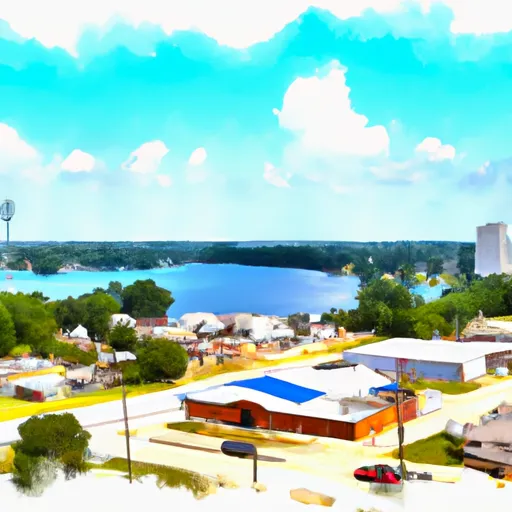-
 Snoflo Premium
Snoflo Premium
Get unlimited access to all our content
With no Ad interruptions! - Start Your Free Trial Login with existing account
Sam-Rayburn
Eden Index
Climate
7.3
•
Recreation
6.5
•
Community
1.7
•
Safeguard
5.6/10

Sam Rayburn is a small city located in Jasper County, Texas. The climate in Sam Rayburn is characterized as humid subtropical, with hot and humid summers and mild winters. Average temperatures range from the 50s in winter to the 90s in summer. The region experiences a moderate amount of rainfall throughout the year.
One of the major highlights of Sam Rayburn is the presence of the Sam Rayburn Reservoir, a massive lake covering approximately 114,500 acres. The reservoir is fed by the Angelina River and serves as a popular outdoor recreation destination. Visitors can engage in activities such as boating, fishing, swimming, and camping. The lake is well-known for its excellent fishing opportunities, particularly for bass fishing, attracting anglers from all over.
The hydrology constituents of Sam Rayburn mainly revolve around the Sam Rayburn Reservoir and the Angelina River, which plays a vital role in maintaining the lake's water levels. This ensures a steady supply of water for various recreational activities and also supports the local ecosystem.
Overall, Sam Rayburn offers a pleasant climate, abundant water resources, and diverse outdoor recreation opportunities, making it an attractive destination for nature enthusiasts and anglers alike.
What is the Eden Index?
The Snoflo Eden Index serves as a comprehensive rating system for regions, evaluating their desirability through a holistic assessment of climate health, outdoor recreation opportunities, and natural disaster risk, acknowledging the profound impact of these factors on livability and well-being.
Climate Health Indicator (CHI): 7.3
Sam-Rayburn receives approximately
1425mm of rain per year,
with humidity levels near 90%
and air temperatures averaging around
19°C.
Sam-Rayburn has a plant hardyness factor of
8, meaning
plants and agriculture in this region tend to thrive here all year round.
By considering the ideal temperature range, reliable water supplies, clean air, and stable seasonal rain or snowpacks, the Climate Health Indicator (CHI) underscores the significance of a healthy climate as the foundation for quality living.
A healthy climate is paramount for ensuring a high quality of life and livability in a region, fostering both physical well-being and environmental harmony. This can be characterized by ideal temperatures, reliable access to water supplies, clean air, and consistent seasonal rain or snowpacks.
Weather Forecast
Streamflow Conditions
Neches
Area Rivers
Neches
Snowpack Depths
Neches
Reservoir Storage Capacity
Neches
Groundwater Levels
Recreational Opportunity Index (ROI): 6.5
The Recreational Opportunity Index (ROI) recognizes the value of outdoor recreational options, such as parks, hiking trails, camping sites, and fishing spots, while acknowledging that climate plays a pivotal role in ensuring the comfort and consistency of these experiences.
Access to outdoor recreational opportunities, encompassing activities such as parks, hiking, camping, and fishing, is crucial for overall well-being, and the climate plays a pivotal role in enabling and enhancing these experiences, ensuring that individuals can engage in nature-based activities comfortably and consistently.
Camping Areas
| Campground | Campsites | Reservations | Toilets | Showers | Elevation |
|---|---|---|---|---|---|
| Claiborne West Park | None | 16 ft | |||
| Sandy Creek - Town Bluff Reservoir | 70 | 112 ft | |||
| Magnolia Ridge - Town Bluff Reservoir | 40 | 90 ft | |||
| Ebenezer - Sam Rayburn Reservoir | 30 | 192 ft | |||
| Village Creek State Park | 41 | 36 ft | |||
| Rayburn - Sam Rayburn Reservoir | 70 | 183 ft | |||
| Martin Dies State Park | 225 | 88 ft | |||
| Campers Cove - Town Bluff Reservoir | None | 93 ft | |||
| Twin Dikes - Sam Rayburn Reservior | 45 | 198 ft | |||
| Sandy Creek | 15 | 161 ft |
Nearby Ski Areas
Catastrophe Safeguard Index (CSI):
The Catastrophe Safeguard Index (CSI) recognizes that natural disaster risk, encompassing floods, fires, hurricanes, and tornadoes, can drastically affect safety and the overall appeal of an area.
The level of natural disaster risk in a region significantly affects safety and the overall livability, with climate change amplifying these risks by potentially increasing the frequency and intensity of events like floods, fires, hurricanes, and tornadoes, thereby posing substantial challenges to community resilience and well-being.
Community Resilience Indicator (CRI): 1.7
The Community Resilience Indicator (CRI) recognizes that education, healthcare, and socioeconomics are crucial to the well-being of a region. The CRI acknowledges the profound impact of these elements on residents' overall quality of life. By evaluating educational resources, healthcare accessibility, and economic inclusivity, the index captures the essential aspects that contribute to a thriving community, fostering resident satisfaction, equity, and social cohesion.

